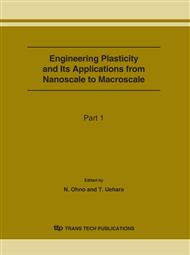p.519
p.525
p.531
p.537
p.543
p.549
p.555
p.563
p.571
Effect of Plastic Working on Pulsating Fatigue Strength of Notched Specimen
Abstract:
In order to study the effect of plastic working on fatigue strength of notched specimen, pulsating fatigue tests had been performed on notched deformed stainless steel specimens including on notched non-deformed specimens in order to evaluate the influence of mean stress on fatigue strength. The test results showed that the fatigue limits of plastic worked specimens are higher than that of non-worked one. This difference value would be caused by residual stress, work hardening and fiber texture due to plastic working. When degree of plastic deformation equal zero ("t=0), the fatigue limit ratio (σw /σB) of SUS430 is the higher than that of SUS304. On the other hand, the fatigue limit of worked specimen for SUS304 increases as the plastic deformation value increases to 0.5 mm and then it does not significantly increase from 0.5 mm to 1 mm. It is necessary to investigate an optimal deformation value.
Info:
Periodical:
Pages:
543-548
Citation:
Online since:
June 2007
Authors:
Price:
Сopyright:
© 2007 Trans Tech Publications Ltd. All Rights Reserved
Share:
Citation:


